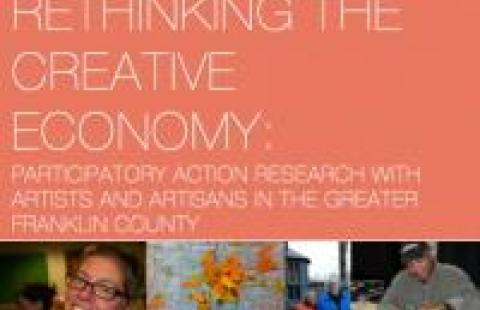What were the project goals?
The goals of the participatory action research (PAR) are (1) to create a pool of indigenous knowledge about the broad range of economic activities that artists and artisans participate in, and how these activities impact the community; (2) create avenues to share this knowledge with the region to increase an understanding of how artists and artisans impact our communities; (3) work with artists and artisans to select activities that foster the growth and adaptation of existing diverse economic practices; and (4) assist the community in recognizing available resources and possible funding sources to support and strengthen their creative economy.
In addition, the project coordinators will publish findings in print and electronic formats, present at local and national conferences, actively seek forums that will assist Franklin County’s endeavors to obtain support and funding for the creative economy, and through a consulting role, help foster the development or expansion of promising practices uncovered through the PAR component of the project. The coordinators also hope to build an interdisciplinary (sociology and geography) curriculum designed to utilize PAR for community economies where we will teach students at the University of Massachusetts and Greenfield Community College how to utilize the tools of PAR to research their own communities and identify opportunities for development.
Have they changed over time?
When the everyday practices of artists and artisans are called economic it moves the economy from an abstract thing that individuals have no control over, to something tangible and actionable. The practices provide both an opportunity to validate the creative economic arrangements of the artists (allowing them to see themselves as economic actors), and provide a set of practices that can be a model for other artists and regional developers.
Julie Graham advised us, “Start where you are.” Utilizing the assets of our researchers, our artists and artisans, we started with their assets, and gifted them with value. From there a transformation occurred from an identity wrought with needs, into an identity of power and agency, where they then had the capacity to induce change within themselves and the population of peers that they interviewed. And finally, the transformed identity of artists can then perform that agency in the broader community in which they participate.
The Rethinking the Creative Economy Project uses poststructuralist participatory action research to disrupt the capitalocentic and needs-based development discourse for the creative economy in the Greater Franklin County, MA. We borrow this strategy from Jenny Cameron, Katherine Gibson, Julie Graham and the Creative Economies Collective. This approach, which uses the disruption to foreground economic diversity and community assets, is a particularly good fit to the creative economy.
Much of the economic activity of this sector falls outside of traditional measures that rely on lodging statistics, tax receipts, and household income. By focusing on non-capitalist practices and a diverse economy, we can engender agency where there was a narrative of subjugation.
Similarly, when we placed value on practices that artists and artisans were engaged in, narratives of survival and success, as defined by the artists and artisans, emerged. Even the narratives of failure, were ones that inspired the research team to learn from and try again. We found that artists and artisans in the region are motivated by a variety of values—community building, creating and sharing beauty, sustainability, and social justice.
Through disrupting the capitalocentric needs-based development discourse, a space opened for regional artisans and artists to define themselves as economic agents and to see their work and values as supportive assets with the potential to transform and perform what was seen as marginal into a viable alternative, a resource to nurture and grow. By defining their own vision of success and prioritizing creative expression, a quality of life can be experienced by artists and artisans, even if it is simultaneously experienced with challenges and hardships. This recognition of a poststructural existence and its multiple realities is central to helping artists and artisans recognize avenues for expanding possibility, and it is central to helping communities evolve into providing more inclusive and intersectional resources for all of its people.
Who are the project partners and stakeholders?
The University of Massachusetts’ President’s Creative Economy Initiatives Fund
Greenfield Community College
The Massachusetts Cultural Council
and
The Fostering Art and Culture Project
